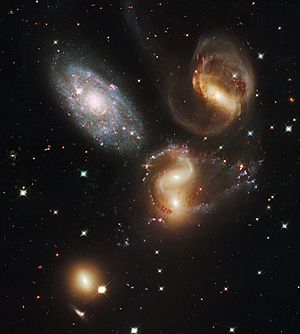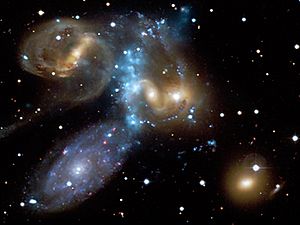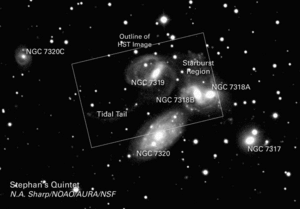Stephan's Quintet facts for kids
Stephan's Quintet is a cool group of five galaxies you can see in the Pegasus constellation. Four of these galaxies were the very first "compact galaxy group" ever found. This means they are packed closely together. They are super far away, about 280 million light-years from Earth!
A French astronomer named Édouard Stephan discovered this group in 1877. He found them while working at the Marseille Observatory.
One of the brightest galaxies in the group is called NGC 7320. It has lots of areas where new stars are being born. These areas look like red clouds in pictures.
A Cosmic Dance of Galaxies
Four of the five galaxies in Stephan's Quintet are truly connected. They are part of something called Hickson Compact Group 92. These four galaxies are doing a "cosmic dance." This means they are slowly pulling each other closer. Eventually, they will likely crash into each other and become one giant galaxy.
Scientists are very interested in these galaxies. They want to learn more about how galaxies interact. They also want to see what happens when they collide.
The Mystery of the Shock Wave
In the 1970s, scientists found something strange. There was a mysterious glow between the galaxies. This glow came from ionized hydrogen gas. You can see it as a beautiful green-blue arc in some pictures.
Recently, two space telescopes helped solve this mystery. They found that the glow is a giant shock wave. Think of it like a sonic boom in space! This shock wave is caused by one galaxy, called NGC 7318B. It is falling into the center of the group super fast. It moves at millions of miles per hour!
The Fifth Galaxy
The fifth galaxy in the group is NGC 7320. It looks like it's part of the group. But it's actually much closer to Earth. It is only about 40 million light-years away. This means it's just in front of the other four galaxies. It is not involved in their cosmic dance.
See also
 In Spanish: Quinteto de Stephan para niños
In Spanish: Quinteto de Stephan para niños




